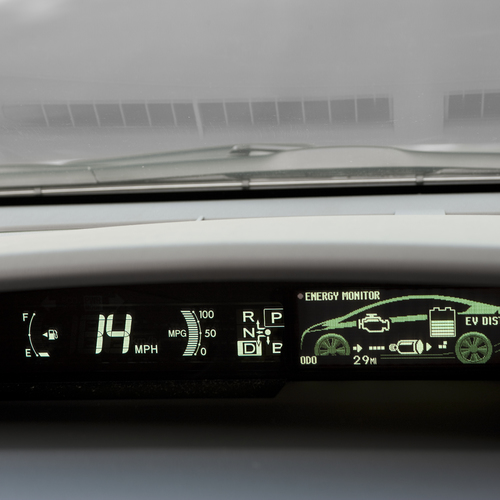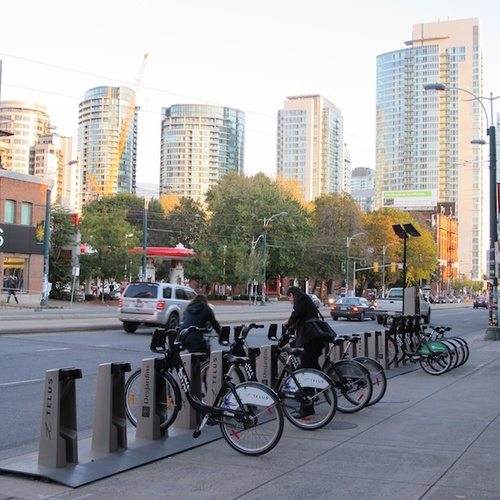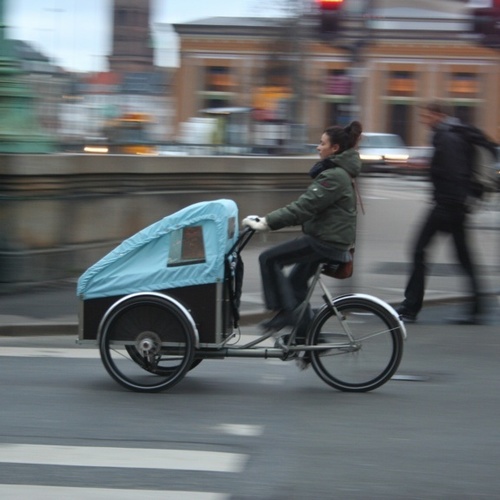
Image Credit: Tom Burke
You’re striving to minimize your carbon footprint, and your house is energy efficient. Through diligent conservation efforts, you’ve greatly reduced the amount of natural gas and electricity required to run your home.
Bravo! But how does your residential energy budget compare to your transportation energy budget? You may be happy to brag about your low utility bills — but if you’re anything like me, you’re probably a little ashamed of your gasoline budget.
How much energy are you pumping into your car? To figure out the relative importance of residential energy versus vehicle energy, let’s do the math.
Counting BTUs
According to data compiled by the Energy Information Administration, the average American household spent $1,841 on residential energy in 2005, not including transportation. Consumption of energy for space heating, hot water, and electrical appliances averaged 97,734,040 Btu (site energy) per household:
Of course, residents of cold states use more fuel for space heating than residents of warm states. Different areas of the country tend to use different fuels; while residents of rural Maine use more heating oil, kerosene, and firewood than the national average, they use much less natural gas.
If you want to perform your own calculations, here’s how to convert fuel use to Btu:
What about gasoline?
The best data I found on automobile transportation are from 2001. In that year, the average American household had 1.9 vehicles; these cars averaged 23.4 miles…
Weekly Newsletter
Get building science and energy efficiency advice, plus special offers, in your inbox.

This article is only available to GBA Prime Members
Sign up for a free trial and get instant access to this article as well as GBA’s complete library of premium articles and construction details.
Start Free TrialAlready a member? Log in















8 Comments
Location, Location, Location
Even more important than gas mileage is where you choose to live.
Living closer to where you work and shop and public transportation should be considered.
Location, Location, Marriage, Babies
The house my wife and I bought, in the place my wife wanted to live, is a just manageable bike commute when it isn't dark and snowy. Which is half the year! But being a just manageable bike commute meant that I didn't always manage it when the weather was nice. There are a lot of hills on my ride, especially on the way back home, and by Thursday my legs would start to get heavy. I am starting to consider the merits of some of the new electric bikes that are out there.
That said, babies have arrived, and the oldest is now in preschool, so I am now car dependent, as I have to drop my daughter off at preschool. I have an old civic I drive to work but the family car is a Subaru Legacy wagon, (I am among the few who really and truly really need AWD). At the time, it was the most fuel efficient AWD car available.
We discovered something when our oldest was old enough to move up to the next size car seat. Since it still had to be installed rear facing, it took up so much room that the front passenger seat had to be be set all the way forward, making the seat unusable for anyone over five feet tall.
It's as though childrens' car seats have been super-sized, designed for mini-vans or SUVs. To be honest I don't know what we are going to do when it comes time for our youngest daughter to move up to the next size of rear facing seat.
We have friends who had a third child, and had to sell their Passat wagon and buy a mini-van because they couldn't get three car seats in the back seat!
It, to me, is an example of how design and the designers preconceptions of the needs of the market segment they are designing for force us to use more energy to go about our daily lives.
Transportation data
You gave as a reference some transport data from 2001. The governments Transportation Energy Data Book might be useful to you. It can be downloaded from http://www-cta.ornl.gov/data/Index.shtml
This was an excellent summary and will help us all make better decisions as to which directions one should take to reduce energy consumption.
You can't improve the bicycle
The bicycle is the most beautiful machine. Basic design hasn't changed in 120 years. Lasts a lifetime with little maintenance. Keeps you healthy. Gets the energy equivalent of 1,600 miles per gallon and I get the fuel from the eggs in my backyard chicken house.
But hey, it's much more fun to talk about the latest mini-split heat pumps from Japan....
Xtracycle
I don't know, Dave. While it sure is fun to talk about the latest and greatest mini-splits, I also like to dream about hauling my blower door equipment around town (to test Passive Houses, of course) on my future Xtracycle...
http://www.flickr.com/photos/xtracycle/3455309851/in/set-72157617044378392/
http://www.xtracycle.com/
Complicated Choices
Location, number of members in your family, how tolerant local drivers are of alternative vehicles, and how tolerant you are of change all play into the equation. In warm, dry climates, a bicycle can be a comfortable and practical mode of transport for just about anyone. In rural Northwest Connecticut it's not so easy.
For anyone who is serious about making a change in personal transportation, there's a great page at [velomobiling.com](http://www.velomobiling.com/transportation) that outlines many options people have for getting around. On that page is a link to an environmental engineering and sustainable infrastructure master's [thesis](http://users.telenet.be/fietser/FVDW.htm) by a student at [KTH Stockholm, Sweden](http://www.infra.kth.se/eesi) that touches on the history of human powered transportation and options for future changes in the technology and infrastructure of transportation.
One alternative that I like, though it's debatable how safe it is for our car-congested roads, is a [velomobile](http://www.velomobiling.com/velomobiles)—a pedal-powered (and electric-assisted, if you like), weather-protected recumbent bicycle or tricycle. Some of these machines can be quite fast and reasonably comfortable.
Don't forget about commercial buildings
Nice article Martin - I like the way you converted everything to a single household - I have not seen statistics in that manner before - they are typically broken out for our contry as a whole - this is easier for people to relate to. However I would like to make one point - some people may read this and come to the conclusion that it is better to spend money on a new car in lieu of weatherization retrofits since the auto consumes 51% of our household's energy. I believe we should focus on buildings first - the average life of a vehicle is approx. 15 years (I just made that up) where as even a decent building will be around approx 100 years so long term better off investing in the home. Also look at it as our country as a whole and include commercial buildings - buildings consume 41% of our energy where transportation is only 28% (2008 data from EIA). I only point this out because our policies sometimes do not make much sense - we should have saved the cash for clunkers money and invested more in weatherization (of all homes not just the low income). Weatherization has longer term paybacks, would have employed more people for longer periods and the cars would have eventually gotten off the road anyway - all we did was speed it up a few years. Still a great article nonetheless.
I couldn't agree with you more
Danny,
Great points — I agree completely.
As you may know, my own background in residential construction makes me predisposed to obsess about buildings. I've always been a big fan of the low-income weatherization program, and for years I've been tearing out my hair at the federal government's lost opportunities to create meaningful weatherization subsidies — while less cost-effective measures (PV, cash for clunkers) receive buckets of cash in the form of tax credits and rebates.
I was inspired to write the above blog, however, by a frank assessment of my own household energy use. For me, the glaring elephant in the room is transportation. The blog is a reminder to myself, and perhaps to a few other readers in my predicament, that we can do better when it comes to transportation.
Log in or become a member to post a comment.
Sign up Log in